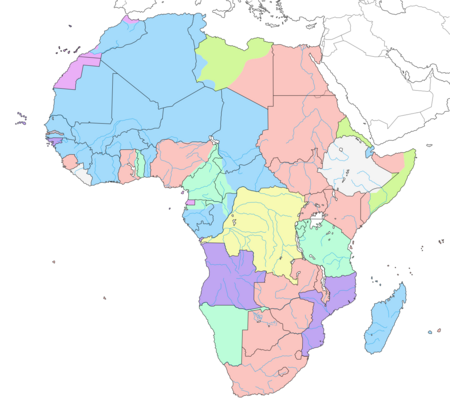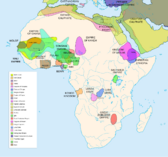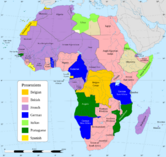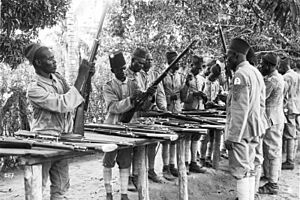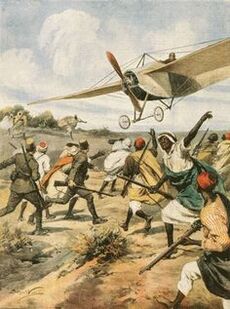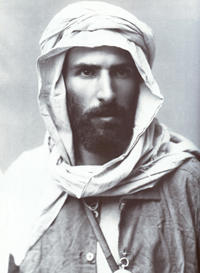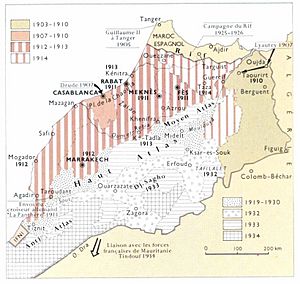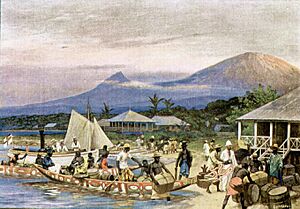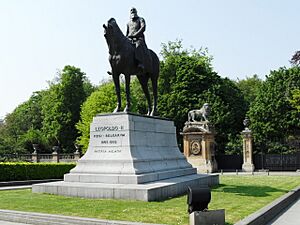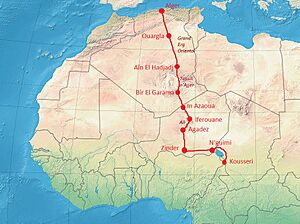Scramble for Africa facts for kids
The Scramble for Africa was a time when several powerful European countries quickly took over and colonized most of Africa. This happened between 1833 and 1914. In 1870, only about 10% of Africa was controlled by Europeans. But by 1914, this number jumped to almost 90%! Only Liberia and Ethiopia remained fully independent.
A big meeting called the Berlin Conference in 1884 helped set the rules for how Europe would divide Africa. This "scramble" was driven by strong competition between European empires. Over time, European influence changed from just having military and economic power to directly ruling these African lands.
After the two World Wars, most African colonies became independent during the Cold War. However, the old borders and economic systems created by the European powers still affect African countries today.
Contents
How the Scramble for Africa Began
Before the mid-1800s, European traders mostly stayed along the coasts of Africa. They set up small trading posts and traded with local people. Moving inland was very dangerous for Europeans because of deadly diseases like malaria. But in the middle of the 19th century, European explorers started mapping out large parts of East Africa and Central Africa.
By the 1870s, Europeans still controlled only about 10% of Africa. Their main territories were Angola and Mozambique (controlled by Portugal), the Cape Colony (controlled by the United Kingdom), and Algeria (controlled by France). By 1914, only Ethiopia and Liberia were not under European control. Ethiopia was later taken over by Italy in 1936. Liberia had strong ties to the United States.
New technologies helped Europeans expand their control. The Industrial Revolution brought faster transportation like steamships and railways. It also brought better communication with telegraphs. Medical advances were also very important. For example, the discovery of quinine, a medicine for malaria, made it safer for Europeans to explore and live in tropical areas.
Why European Countries Wanted Africa
Africa's Role in Global Trade
Africa, especially south of the Sahara Desert, was seen as a new place for businesses to grow. At a time when Britain's trade was slowing down, Africa offered a new market. European countries like Britain, Germany, and France could sell more goods to Africa than they bought from it.
Investing money overseas became more profitable. Africa had cheap materials, little competition, and lots of raw materials. These raw materials included ivory, rubber, palm oil, cocoa, diamonds, tea, and tin. Britain also wanted control of parts of southern and eastern Africa for ports. These ports would be useful stops on the way to its large empire in India. However, not much European money was actually invested in Africa, except in the area that became South Africa.
Some people who supported imperialism, like Jules Ferry, argued that new markets in Africa would solve problems of low prices and too many goods in Europe.
Competition Between European Powers
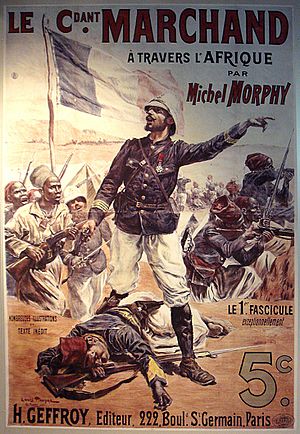
Even though tropical Africa wasn't a huge place for investments, it was important for other reasons. The large area between Egypt and the gold and diamond-rich Southern Africa was important for protecting trade routes. Britain needed to protect its trade with India, Malaya, Australia, and New Zealand. This meant securing the Suez Canal, a key waterway completed in 1869.
European countries also wanted military and naval bases in Africa. Growing navies needed places to refuel and repair ships. Defense bases were also needed to protect sea routes and communication lines, especially for important waterways like the Suez Canal.
Colonies were also seen as a way to gain power in international talks. Countries with large local populations could also use them as soldiers. Britain used many soldiers from India, and France used soldiers from North Africa in their colonial wars. In a time of strong nationalism, having an empire showed a country's power and importance.
In the early 1880s, Pierre Savorgnan de Brazza explored the Congo River region for France. At the same time, Henry Morton Stanley explored it for Leopold II of Belgium. Leopold wanted the Congo as his personal territory, which became the Congo Free State. France took over Tunisia in 1881. In 1882, Britain took over Egypt, which also controlled Sudan and parts of Chad, Eritrea, and Somalia. In 1884, Germany claimed Togoland, the Cameroons, and South West Africa. France also took over Guinea.
Germany's Weltpolitik
Germany was not a colonial power at first. But after uniting in 1871, it started to look for colonies. Otto von Bismarck, Germany's leader, at first didn't like colonies. But he gave in to public pressure in the 1880s. He helped organize the 1884–85 Berlin Conference. This meeting set rules for controlling African lands and helped prevent wars between colonial powers.
Germany became the third-largest colonial power in Africa. By 1914, it controlled 2.6 million square kilometers of land and 14 million people. Its African colonies included Southwest Africa, Togoland, the Cameroons, and Tanganyika. Germany tried to challenge France's power in Morocco, leading to the First Moroccan Crisis in 1905 and the Agadir Crisis in 1911.
Italy's Expansion
After uniting in 1861, Italy also wanted to expand its territory. It took parts of Eritrea in 1870 and 1882. In 1889–90, Italy took land in the Horn of Africa, forming Italian Somaliland. Italy also claimed a new colony called Eritrea. When relations with Ethiopia worsened, the First Italo-Ethiopian War broke out in 1895. Italian troops were defeated because the Ethiopians had more soldiers and support from Russia and France.
In 1911, Italy fought a war with the Ottoman Empire. Italy gained Tripolitania and Cyrenaica, which together became Italian Libya. Later, under the dictator Benito Mussolini, Italy fought the Second Italo-Ethiopian War (1935–1936). This was the last major colonial war. Italy took over Ethiopia, which had been the last independent African territory besides Liberia.
Key Events and Characteristics
The Congo Region
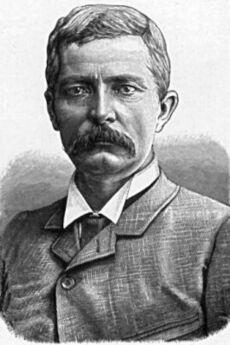
The explorations of David Livingstone and Henry Morton Stanley sparked interest in colonizing the Congo. Leopold II of Belgium was especially interested. From 1869 to 1874, Stanley secretly worked for Leopold II in the Congo. He made agreements with many African chiefs. By 1882, he had enough land to form the Congo Free State, which was Leopold's personal property.
While Stanley explored for Leopold, a French officer named Pierre de Brazza explored the western Congo Basin. In 1881, he raised the French flag over the new city of Brazzaville, claiming the area for France. Portugal also claimed the area.
By 1890, the Congo Free State controlled its territory. At the same time, Cecil Rhodes's British South Africa Company was expanding north from the Limpopo River.
A powerful Arab trader named Tippu Tip also played a big role. He traded ivory and slaves in East Africa. He worked with European explorers and even became a governor in Leopold's Congo Free State for a time.
The region of Katanga was very rich in copper, ivory, and possibly gold. It was ruled by Msiri, a powerful leader. Leopold sent several expeditions to take Katanga. The Stairs expedition was ordered to take Katanga by force if needed. Msiri refused and was killed. His head was put on a pole as a warning. This way, Leopold gained Katanga, making his African territory huge. The Congo Free State was known for its harsh rule. Because of this, Belgium took control from Leopold in 1908, and it became the Belgian Congo.
The rule of King Leopold II in the Congo Free State was very cruel. Many people died due to harsh treatment, starvation, and diseases like sleeping sickness and smallpox. It is hard to know the exact number of deaths because there were no proper records until 1924.
Egypt, Sudan, and the Suez Canal
The Suez Canal
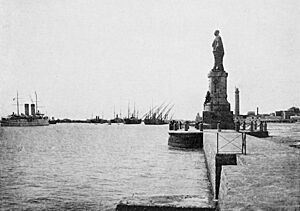
The Suez Canal was built by French diplomat Ferdinand de Lesseps. He got permission from Isma'il Pasha, the ruler of Egypt and Sudan. Many workers died during the ten years of construction from disease and hard labor. When the canal was almost finished in 1869, Isma'il Pasha borrowed a lot of money from British and French banks. By 1875, he had to sell his shares in the Suez Canal. Britain, led by Prime Minister Benjamin Disraeli, quickly bought these shares. This gave Britain control over this important waterway. When Isma'il Pasha refused to pay back Egypt's foreign debt in 1879, Britain and France took control of Egypt's finances. They forced Isma'il to step down and put his son Tewfik Pasha in charge.
The Mahdist War
In the 1870s, European efforts to stop the slave trade caused problems in northern Sudan. This led to the rise of Mahdist forces. In 1881, a revolt started in Sudan led by Muhammad Ahmad. This weakened Tewfik's control. In 1882, Tewfik asked Britain for military help. This began Britain's control over Egypt. British and Egyptian forces fought the Mahdist forces in Sudan. They finally defeated them in 1898. After this, Britain took control of Sudan, calling it Anglo-Egyptian Sudan.
The Berlin Conference (1884–1885)
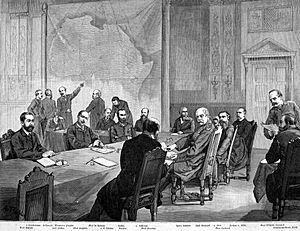
The takeover of Egypt and the Congo were the first big steps in the Scramble for Africa. In 1884, Otto von Bismarck called the Berlin Conference. The main goal was to prevent wars between European powers as they divided Africa. They also discussed ending the slave trade and missionary work. The diplomats set rules for how countries could claim colonies. They agreed that the Congo River area would be neutral and open for trade. Countries had to tell others about their plans to claim land. They also had to actually control the land before formally claiming it. However, countries often ignored these rules, and wars were sometimes barely avoided.
Britain's Control in Egypt and South Africa
Britain's control of Egypt and the Cape Colony made them want to secure the source of the Nile River. Britain took over Egypt in 1882. Sudan, Nigeria, Kenya, and Uganda were taken over in the 1890s and early 1900s. In the south, the Cape Colony became a base for taking over nearby African states and the Dutch Afrikaner settlers. The British fought two wars with the Boers (Dutch settlers) over control of gold and diamond industries. The Second Boer War (1899–1902) resulted in the Boer republics becoming part of the British Empire.
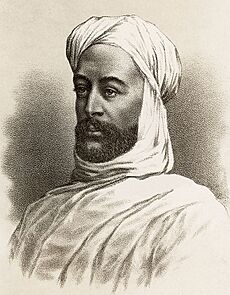
Britain wanted to connect its territories from Cape Town in the south to Cairo in the north. This idea was called "Cape to Cairo" and was strongly supported by Cecil Rhodes. France wanted to connect its territories from Dakar to Sudan, stretching across the continent. These two goals clashed in eastern Sudan, near Fashoda.
A French force arrived at Fashoda first, followed by a British force. The French eventually pulled back after a tense standoff. This event, known as the Fashoda Incident, led to the Entente Cordiale agreement in 1904, which helped keep peace between Britain and France.
Moroccan Crises
Even after the Berlin Conference, competition between European powers remained strong. Germany decided to test the strength of the Entente Cordiale by challenging France's influence in Morocco. In 1905, German Kaiser Wilhelm II visited Tangier and spoke in favor of Moroccan independence. This angered France. The crisis was settled at the 1906 Algeciras Conference. Germany found little support and eventually agreed to France keeping control of key areas in Morocco.
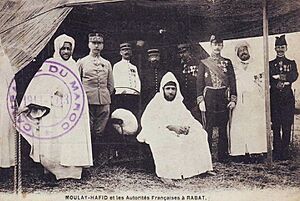
Five years later, in 1911, the Agadir Crisis happened when Germany sent a gunboat to the port of Agadir. Britain worried Germany wanted a naval base there. Germany's goal was to get more land in exchange for accepting French control in Morocco. A deal was made in November 1911. Germany accepted France's position in Morocco in return for a piece of land in French Equatorial Africa.
France and Spain then fully took over Morocco as a protectorate in 1912. Britain's support for France during these crises strengthened their alliance and increased tensions between Britain and Germany. These tensions helped lead to World War I.
Resistance to Colonial Rule
Dervish Resistance
After the Berlin Conference, the British, Italians, and Ethiopians tried to claim lands where the Somalis lived. The Dervish movement, led by Sayid Muhammed Abdullah Hassan, fought against the British Empire for 21 years (1899–1920). The Dervishes successfully pushed back the British four times, forcing them to stay near the coast. Because of their success, the Dervish movement was seen as an ally by the Ottoman and German empires. The Dervishes were finally defeated in 1920 when Britain used airplanes against them.
Herero and Maji Maji Rebellions
Between 1904 and 1908, Germany's colonies in German South West Africa and German East Africa faced revolts from local people. German forces quickly defeated these threats once more soldiers arrived from Germany. The Herero rebels in German South West Africa were defeated at the Battle of Waterberg. The Maji-Maji rebels in German East Africa were slowly crushed by German forces.
The German efforts to control the population in German South West Africa led to a terrible loss of life. Many thousands of Herero and Nama people died from starvation, thirst, or harsh labor in camps between 1904 and 1908.
Ideas Behind Colonialism
Colonial Support and Public Opinion
Colonial Lobby
At first, many political leaders, like William Ewart Gladstone, were against the expensive idea of colonization. But over time, groups that supported colonies, called "colonial lobbies," grew stronger. These groups helped convince people that overseas adventures were needed. In Germany, France, and Britain, many middle-class people wanted strong overseas policies to help their economies grow.
Some people, like Hannah Arendt, argued that taking over overseas territories went against the idea of a nation-state where everyone is a citizen. This created a conflict between respecting the human rights of colonized people and the desire to use them for resources. Writers like Joseph Conrad in Heart of Darkness showed the harsh realities of colonial rule.
Colonial Propaganda and Exhibitions
Colonial powers used propaganda to make people proud of their empires. They spread ideas and images that showed it was Europe's duty to bring "civilization" to other peoples. This was called the mission civilisatrice (civilizing mission) in France.
By the end of World War I, colonial empires were very popular in Europe. Public opinion had been convinced that colonies were necessary. Colonial exhibitions played a big role in changing how people thought. These exhibitions often showed indigenous people for scientific and entertainment purposes, sometimes in "human zoos." These displays were very popular, with hundreds of thousands of visitors. Sadly, some of the indigenous people died because they were not used to the climate conditions.
Fighting Disease
From the early 1900s, European powers focused on controlling diseases in tropical countries. For example, the sleeping sickness epidemic in Africa was stopped by mobile teams checking millions of people. In the 1880s, cattle brought from Asia to feed Italian soldiers spread a disease called rinderpest. This disease badly hurt local cattle herds, forcing people to work for their colonizers.
In the 20th century, Africa's population grew a lot. This was due to more peace, help during famines, better medicine, and especially the end or decline of the slave trade. Africa's population grew from 120 million in 1900 to over 1 billion today.
Ending Slavery
The movement to end slavery in Western Europe became a reason and an excuse for colonizing Africa. Most colonial rulers claimed they wanted to stop slavery and the slave trade. In French West Africa, after the French took over and ended slavery, over a million enslaved people ran away between 1906 and 1911. In Madagascar, the French ended slavery in 1896, freeing about 500,000 enslaved people. Slavery was mostly ended by colonial powers, though it continued in some parts of Africa, slowly changing to a wage economy.
What Happened After
By the end of the 19th century, European countries had added almost 9 million square miles of land to their empires. This was about one-fifth of the Earth's land area. Europe controlled almost all of Africa, except for Ethiopia, Liberia, and Saguia el-Hamra. Between 1885 and 1914, Britain controlled about 30% of Africa's population. France controlled 15%, Portugal 11%, Germany 9%, Belgium 7%, and Italy 1%.
The competition between these powerful countries led to several crises. These tensions eventually exploded in August 1914, leading to World War I.
African Colonies by European Power
Belgium
- Belgian Congo (1908–1960, now the Democratic Republic of the Congo)
- Ruanda-Urundi (1922–1962, now Rwanda and Burundi)
France
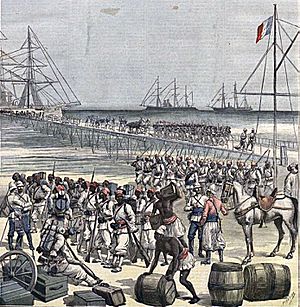
- French West Africa:
- Mauritania
- Senegal
- Albreda (1681–1857, now part of Gambia)
- French Sudan (now Mali, 1880 – 1958)
- French Guinea (now Guinea)
- Ivory Coast
- Niger
- French Upper Volta (now Burkina Faso)
- French Dahomey (now Benin)
- French Togoland (1916–60, now Togo)
- French Equatorial Africa:
- Gabon
- French Cameroun (1922–60)
- French Congo (now Republic of the Congo)
- Oubangui-Chari (now Central African Republic)
- Chad
- French North Africa:
- French Algeria (1830–1962; was part of France from 1848)
- French Protectorate of Tunisia
- French Protectorate of Morocco
- Fezzan-Ghadames (1943–1951)
- French East Africa:
- French Madagascar
- Comoros
- Scattered islands in the Indian Ocean
- French Somaliland (now Djibouti)
- Isle de France (1715–1810) (now Mauritius)
Germany
- German Kamerun (now Cameroon and part of Nigeria, 1884–1916)
- German East Africa (now Rwanda, Burundi and most of Tanzania, 1885–1919)
- German South-West Africa (now Namibia, 1884–1915)
- German Togoland (now Togo and eastern part of Ghana, 1884–1914)
After World War I, Germany's colonies were divided among Britain, France, and Belgium.
Italy
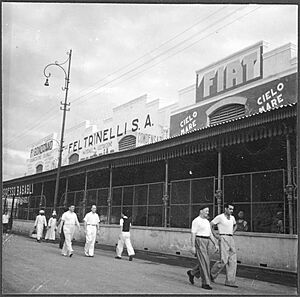
- Italian Eritrea (1882-1936)
- Italian Somalia (1889-1936)
- Italian Ethiopia (1936-1941)
- Libya
- Italian Tripolitania (1911-1934)
- Italian Cyrenaica (1911-1934)
- Italian Libya (from 1934) (1934-1943)
Portugal
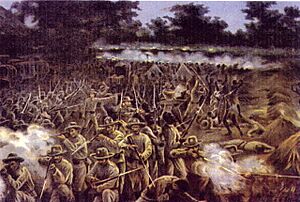
- Portuguese Angola (now Angola)
- Mainland Angola
- Portuguese Congo (now Cabinda Province of Angola)
- Portuguese Mozambique (now Mozambique)
- Portuguese Guinea (now Guinea-Bissau)
- Portuguese Gold Coast (now part of Ghana)
- Portuguese Cape Verde
- Portuguese São Tomé and Príncipe
- São Tomé Island
- Príncipe Island
- Fort of São João Baptista de Ajudá (now Ouidah, in Benin)
Spain
- Northern Spanish Morocco
- Spanish West Africa
- Ifni
- Southern Spanish Morocco (Cape Juby)
- Spanish Sahara (now Western Sahara)
- Spanish Guinea (now Equatorial Guinea)
United Kingdom
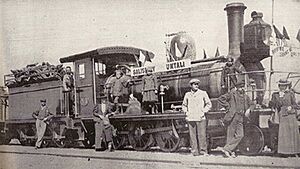
Britain wanted to keep its trade routes to India safe. This led to their interest in Egypt and South Africa. Once these areas were secure, British colonialists like Cecil Rhodes wanted to build a railway from Cape to Cairo. They also wanted to use Africa's minerals and farm resources. By 1921, Britain controlled about 33% of Africa.
- Egypt
- British Cyrenaica (1943–1951, now part of Libya)
- British Tripolitania (1943–1951, now part of Libya)
- Anglo-Egyptian Sudan (1899–1956)
- British Somaliland (now part of Somalia)
- British East Africa:
- Kenya Colony
- Uganda Protectorate
- Tanzania :
- Tanganyika Territory (1919–61)
- Zanzibar
- British Mauritius
- Bechuanaland (now Botswana)
- Southern Rhodesia (now Zimbabwe)
- Northern Rhodesia (now Zambia)
- British Seychelles
- British South Africa
- South Africa:
- Transvaal Colony
- Cape Colony
- Colony of Natal
- Orange River Colony
- South-West Africa (from 1915, now Namibia)
- South Africa:
- British West Africa
- Gambia Colony and Protectorate
- British Sierra Leone
- Colonial Nigeria
- British Togoland (1916–56, today part of Ghana)
- Cameroons (1922–61, now part of Cameroon and Nigeria)
- Gold Coast (British colony) (now Ghana)
- Nyasaland (now Malawi)
- Basutoland (now Lesotho)
- Swaziland (now Eswatini)
- Saint Helena, Ascension and Tristan da Cunha
Independent African States
Liberia was founded and controlled by the American Colonization Society. This group helped free African American and Caribbean slaves move from the United States and the Caribbean islands in 1822. Liberia declared its independence in 1847. It is Africa's oldest republic. European powers saw Liberia as connected to the United States, so it remained independent.
Ethiopia was also seen as an Italian protectorate by some, but it never accepted this. Its independence from Italy was recognized after the Battle of Adwa in 1896. Except for a period of Italian occupation between 1936 and 1941, Ethiopia is Africa's oldest independent nation.
See also
 In Spanish: Reparto de África para niños
In Spanish: Reparto de África para niños
- Chronology of Western colonialism
- List of European colonies in Africa
- List of kingdoms in Africa throughout history
- List of former sovereign states
- List of French possessions and colonies
- Analysis of Western European colonialism and colonization
- Durand Line
- Economic history of Africa
- French colonial empire
- Historiography of the British Empire
- International relations (1814–1919)
- Scramble for China
- Sykes–Picot Agreement
- White Africans of European ancestry


